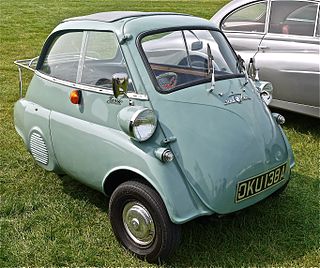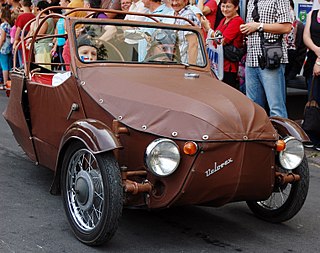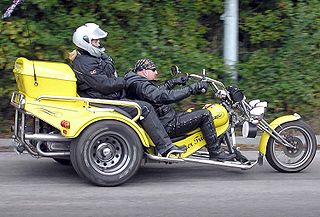
A motorcycle, often called a bike, motorbike, or cycle, is a two- or three-wheeled motor vehicle. Motorcycle design varies greatly to suit a range of different purposes: long distance travel, commuting, cruising, sport including racing, and off-road riding. Motorcycling is riding a motorcycle and related social activity such as joining a motorcycle club and attending motorcycle rallies.

An anti-lock braking system (ABS) is a safety anti-skid braking system used on aircraft and on land vehicles, such as cars, motorcycles, trucks and buses. ABS operates by preventing the wheels from locking up during braking, thereby maintaining tractive contact with the road surface.

Steering is the collection of components, linkages, etc. which allows any vehicle to follow the desired course. An exception is the case of rail transport by which rail tracks combined together with railroad switches provide the steering function. The primary purpose of the steering system is to allow the driver to guide the vehicle.

A gyrocar is a two-wheeled automobile. The difference between a bicycle or motorcycle and a gyrocar is that in a bike, dynamic balance is provided by the rider, and in some cases by the geometry and mass distribution of the bike itself, and the gyroscopic effects from the wheels. Steering a motorcycle is done by precessing the front wheel. In a gyrocar, balance was provided by one or more gyroscopes, and in one example, connected to two pendulums by a rack and pinion.

The Isetta is an Italian-designed microcar built under license in a number of different countries, including Argentina, Spain, Belgium, France, Brazil, Germany, and the United Kingdom. Because of its egg shape and bubble-like windows, it became known as a bubble car, a name also given to other similar vehicles.

A bicycle fork is the part of a bicycle that holds the front wheel.

Countersteering is used by single-track vehicle operators, such as cyclists and motorcyclists, to initiate a turn toward a given direction by momentarily steering counter to the desired direction. To negotiate a turn successfully, the combined center of mass of the rider and the single-track vehicle must first be leaned in the direction of the turn, and steering briefly in the opposite direction causes that lean. The rider's action of countersteering is sometimes referred to as "giving a steering command".

A three-wheeler is a vehicle with three wheels. Some are motorized tricycles, which may be legally classed as motorcycles, while others are tricycles without a motor, some of which are human-powered vehicles and animal-powered vehicles.
The Killinger and Freund Motorcycle was an attempt in 1935 by a group of five German engineers from Munich to design a more streamlined and modified version of the German Megola front-wheel drive motorcycle. The work took three years to complete but the result was impressive. The engine displacement stayed the same as the Megola at 600 cc but was much lighter and more simplified than a standard 100 cc motorcycle of the time.
FIM Sidecar World Championship is the international sidecar racing championship. It is the only remaining original FIM road racing championship class that started in 1949.

The Grinnall Scorpion III, by Grinnall Specialist Cars, is a reverse trike, with two wheels at the front and one at the rear, which is a better-handling configuration than one wheel at the front. Designed in 1991 by Steve Harper, the Scorpion III features a GRP body tub which is bonded to a space frame chassis underneath, and employs a BMW K-series motorcycle engine as its power plant. The engine, gearbox and final drive from the motorcycle are utilised with a special rear wheel which is fitted with a car tyre, as are the front wheels. It has a very good power-to-weight ratio which endows it with excellent performance. The rear wheel is of a smaller circumference than the bike's wheel so the gearing is optimised for a lower top speed of around 125 mph (201 km/h) with 0-60 mph taking around 6 seconds when using a K1100 engine. Any BMW K engine can be used, from a 750 cc 3-cylinder, to a 1200 cc, 4-cylinder, giving power outputs from 75 bhp (56 kW) to 130 bhp (97 kW).
Rengsjöbilen, Jonsson or just "Bilen" was the names given to a series of ten cars made by sawmill owner Anders Jonsson in Rengsjö, Hälsingland between 1914 and 1916. The cars were two-seater in tandem. Length 320 cm and width 120 cm. Weight 445 kg. The engine was 75x100 cc. The body, fenders, chassis and so on was made by Höjens verkstäder in Rengsjö. Many components, like motorcycle wheels, chains, engine and so on, were bought from other sources. The engine is said to be a water-cooled, two-cylinder, two-stroke made in Morgårdshammar mainly intended for boats. It is reported to have produced between 6 and 10 hp. When production ended several persons joined the car production at SAF in Bollnäs.

Bicycle and motorcycle dynamics is the science of the motion of bicycles and motorcycles and their components, due to the forces acting on them. Dynamics falls under a branch of physics known as classical mechanics. Bike motions of interest include balancing, steering, braking, accelerating, suspension activation, and vibration. The study of these motions began in the late 19th century and continues today.

The Ner-A-Car was a type of feet forwards motorcycle designed by Carl Neracher in 1918. It used an unusual steel-channel chassis, much like an automobile, and hub-center steering at the front wheel, making it 'nearly a car' in design. The Ner-A-Car was the most successful hub-center steering motorcycle ever produced, with sales far eclipsing earlier or later examples of this design, such as the Yamaha GTS1000 or Bimota Tesi. About 10,000 Neracars were manufactured in the United States by the Ner-A-Car Corporation, while around 6,500 are believed to have been produced in England under licence by the Sheffield-Simplex company between 1921 and 1926 under the Ner-A-Car name.
A motorcycle's suspension serves a dual purpose: contributing to the vehicle's handling and braking, and providing safety and comfort by keeping the vehicle's passengers comfortably isolated from road noise, bumps and vibrations.

A motorcycle fork connects a motorcycle's front wheel and axle to its frame, typically via a yoke, also known as a triple clamp, which consists of an upper yoke joined to a lower yoke via a steering stem, a shaft that runs through the steering head, creating the steering axis. Most forks incorporate the front suspension and front brake, and allow the front wheel to rotate about the steering axis so that the bike may be steered. Most handlebars attach to the top clamp in various ways, while clip-on handlebars clamp to the fork tubes, either just above or just below the upper triple clamp.

Bicycle and motorcycle geometry is the collection of key measurements that define a particular bike configuration. Primary among these are wheelbase, steering axis angle, fork offset, and trail. These parameters have a major influence on how a bike handles.

Velorex was a manufacturing cooperative in Solnice, Czechoslovakia. Notable products included a small three-wheeled car, produced from the 1950s until 1971, and the Type 562 sidecar. The sidecar is still manufactured in the Czech Republic by Velorexport, the successor to Velorex.

A motorized tricycle, motor trike, or three-wheeled motorcycle is a three-wheeled vehicle based on the same technology as a bicycle or motorcycle, and powered by an electric motor, motorcycle, scooter or car engine. These are mainly used by old motorcyclists that can not reverse using their feet

The Polaris Slingshot is a three-wheeled motor vehicle. The first edition of the model was introduced in 2014 as a 2015 model.



















